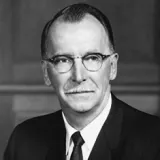
Lyman Rowell was designated to succeed Shannon McCune at a meeting of the trustees held on August 7, 1966. Rowell was the consummate insider, who had served UVM throughout his professional career and had twice before been interim president of the university.
Lyman S. Rowell was born in Colebrook, New Hampshire, on May 8, 1904. His family moved to Vermont when he was eight years old. After graduating from UVM in 1925, he joined the faculty and received a master’s degree in zoology in 1930. He married Mae Tinkham ’31. Their daughter, Marjorie, graduated from the university in 1955. Prior to being selected as UVM’s nineteenth president, Rowell had established a reputation as an excellent teacher who had also performed a staggering variety of administrative tasks, including acting director of the Fleming Museum (1932–33), director of the summer session (1951–58), director of adult education (1955–56), dean of administration (1956–65), acting president (1958 and 1964), and vice president for administrative and student affairs (1965–66).
In retrospect, the trustees made an astute choice in selecting Rowell because he had the background, experience, and ability to provide firm leadership during the tumultuous period of student unrest that marked the Vietnam era. During Rowell’s four-year term as president, he dealt with a range of campus protests against institutions such as ROTC (which was retained) and Kake Walk (which was abolished in 1969), as well as other socially controversial issues. He attempted to maintain open channels of communication with students and dissident groups in an effort to find common solutions. As he noted in his 1969 report, “This is a time when all men of reason and good will must work together to minimize confrontation and emphasize dialogue.” In speaking to an alumni luncheon that same year, he stated, “There are few earthly things more splendid than a university — wherever a university stands — it stands and shines. . . . I cannot subscribe to the solitary emphasis that the university is run for or by any of its constituent groups, be it the alumni or students or faculty or a political division of the state. We must seek to secure the participation of all groups on the councils of the university.”
Despite the campus turmoil, Rowell was able to guide UVM forward into a new era of growth. When he became president in 1966, construction projects valued at more than $10 million were under way, with additional projects totaling another $5 million on the drawing board. In 1968 the $8.7 million Given Medical Building and the $2 million Marsh Life Sciences Building were both dedicated. By this time UVM had expanded to a point that Rowell thought it important to assert, “We are still a small university and we do not plan to become a mammoth one.” Yet, questions remained about what this meant and how large UVM should grow in the future.
In the spring of 1969, the trustees devoted major attention to the future development of the university. After reaffirming the traditional policy of admitting all qualified Vermonters, they authorized continued expansion of future enrollments to a total of nine thousand students by 1975. During Rowell’s presidency, UVM increased its undergraduate enrollment from 4,200 to 5,800 students. The university began an innovative experimental college program for undergraduates and a new overseas study program in France, established the Lake Champlain Studies Center, and continued to expand its graduate commitments by adding doctoral programs in psychology and electrical engineering. In addition, the university helped to launch a new state educational television network, established two new endowed faculty chairs (the Lawrence and Sanders professorships), and saw its budget double from $15 million in 1965 to almost $30 million in 1970.
After President Rowell retired in 1970, he continued to live in the Burlington area. He was active in the community, serving Champlain College, the Medical Center Hospital, and the Vermont Historical Society. When he died at the age of eighty on September 26, 1984, one of his former students, Dr. Edward C. Andrews, called him “a great teacher and a great mentor.” Lyman S. Rowell had served The University of Vermont faithfully in many different capacities over the course of nearly a half-century.